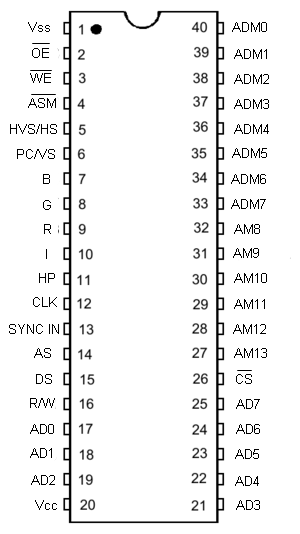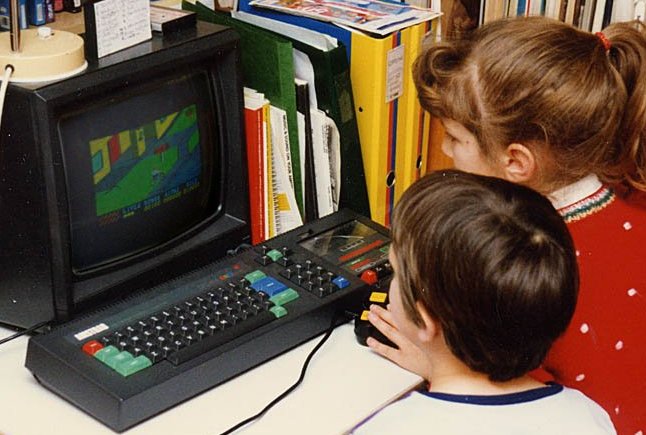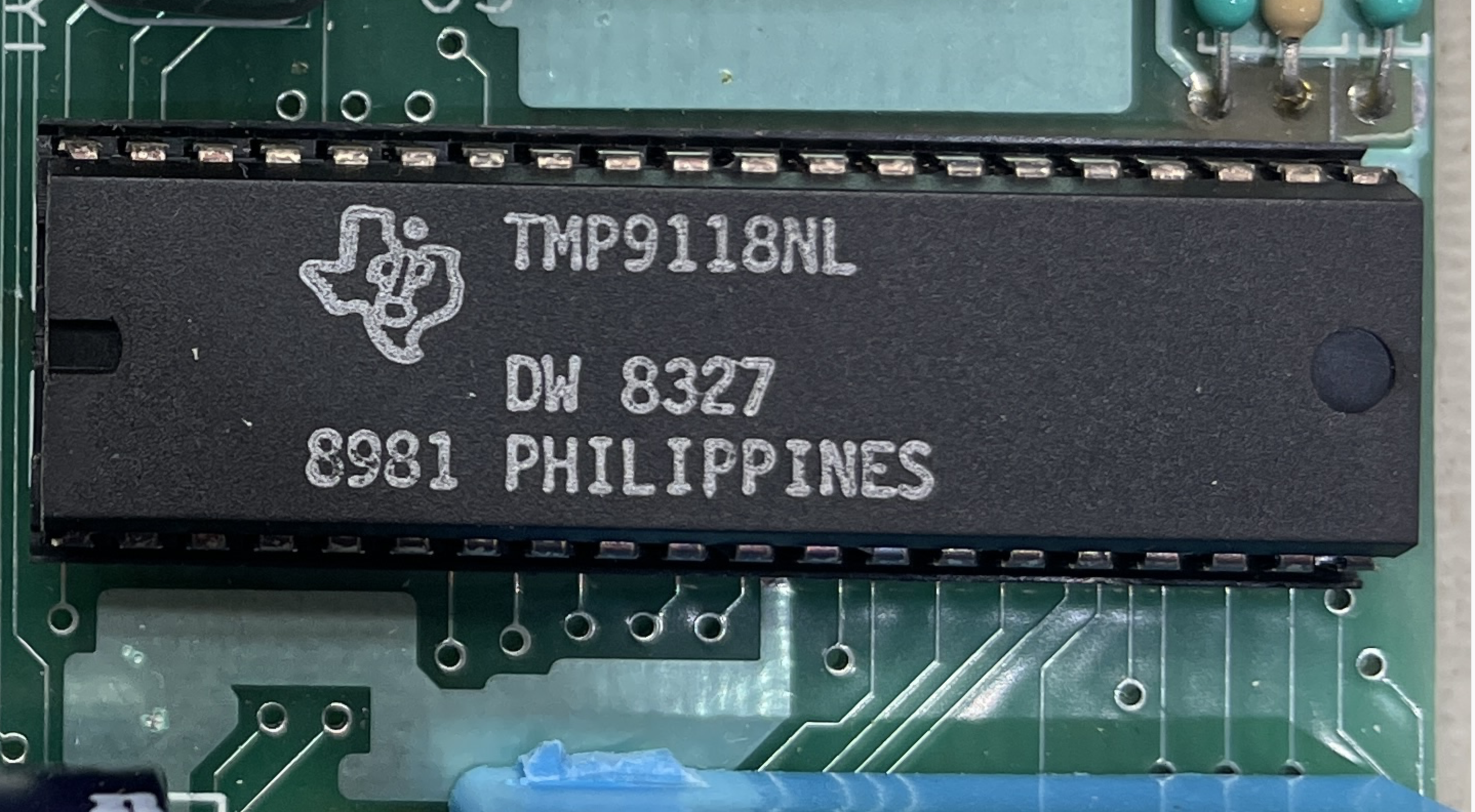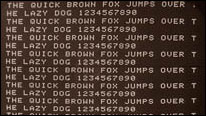|
Thomson EF9345
The EF9345 from SGS-Thomson Microelectronics, Inc., was a semigraphic single chip microprocessor for video image control, encapsulated in a 40-pin DIP and used primarily in the Matra Alice 32, Matra Alice 90 and Philips VG5000 microcomputers. It was also the video processor of the Minitel 1b terminals, built by either Alcatel and Philips at more than 2 million of units. The EF9345 was capable of displaying 8 colors ( RGB primaries), 128 alphanumeric characters and 128 semigraphic characters. It had one semigraphic mode and 40- and 80-column text modes. It was able to address up to 16KB of dedicated video RAM. Video Modes * 50/60Hz output ** Interlaced or progressive scan *Semigraphics: ** 128 standard character set with 5×7 pixel font dimensions. User definable 8×10 pixel alphanumeric or semigraphic sets. *40 characters × 25 rows text mode (similar to teletext): ** 8 × 10 pixel font ** Selectable background and foreground colors ** Styles: double height, double width, blin ... [...More Info...] [...Related Items...] OR: [Wikipedia] [Google] [Baidu] |
ASCII
ASCII ( ), an acronym for American Standard Code for Information Interchange, is a character encoding standard for representing a particular set of 95 (English language focused) printable character, printable and 33 control character, control characters a total of 128 code points. The set of available punctuation had significant impact on the syntax of computer languages and text markup. ASCII hugely influenced the design of character sets used by modern computers; for example, the first 128 code points of Unicode are the same as ASCII. ASCII encodes each code-point as a value from 0 to 127 storable as a seven-bit integer. Ninety-five code-points are printable, including digits ''0'' to ''9'', lowercase letters ''a'' to ''z'', uppercase letters ''A'' to ''Z'', and commonly used punctuation symbols. For example, the letter is represented as 105 (decimal). Also, ASCII specifies 33 non-printing control codes which originated with ; most of which are now obsolete. The control cha ... [...More Info...] [...Related Items...] OR: [Wikipedia] [Google] [Baidu] |
List Of Home Computers By Video Hardware
This is a list of home computers, sorted alphanumerically, which lists all relevant details of their video hardware. Home computers are the second generation of desktop computers, entering the market in 1977 and becoming common during the 1980s. A decade later they were generally replaced by IBM PC compatible "PCs", although technically home computers are also classified as personal computers. Examples of early home computers are the TRS-80, Atari 8-bit computers, BBC Micro, ZX Spectrum, MSX, Amstrad CPC 464, and Commodore 64. Examples of late home computers are MSX 2 systems, and the Amiga and Atari ST systems. Note: in cases of manufacturers who have made both home and personal computers, only machines fitting into the ''home'' computer category are listed. Systems in the personal computer category, except for Early Macintosh PCs, are generally based on the VGA standard and use a video chip known as a Graphics Processing Unit. Very early PCs used one of the much simpler (even ... [...More Info...] [...Related Items...] OR: [Wikipedia] [Google] [Baidu] |
MOS Technology VIC-II
The VIC-II (Video Interface Chip II), specifically known as the MOS Technology 6567/6566/8562/8564 (NTSC versions), 6569/8565/8566 (PAL), is the microchip tasked with generating Y/C video signals (combined to composite video in the RF modulator) and DRAM refresh signals in the Commodore 64 and Commodore 128 home computers. Succeeding the original MOS Technology VIC used in the VIC-20, the VIC-II was one of the key custom chips in the Commodore 64 (the other being the MOS Technology 6581 sound chip). Development history The VIC-II chip was designed primarily by Albert Charpentier and Charles Winterble at MOS Technology, Inc. as a successor to the MOS Technology 6560 "VIC". The team at MOS Technology had previously failed to produce two graphics chips named ''MOS Technology 6562'' for the Commodore TOI computer, and ''MOS Technology 6564'' for the Color PET, due to memory speed constraints. In order to construct the VIC-II, Charpentier and Winterble made a market survey of ... [...More Info...] [...Related Items...] OR: [Wikipedia] [Google] [Baidu] |
TMS9918
IMAGE:TMS9918A 01.jpg, VDP TMS9918A IMAGE:TMS9918A 02.jpg, VDP TMS9918A The TMS9918 is a video display controller (VDC) manufactured by Texas Instruments, in manuals referenced as "Video Display Processor" (VDP) and introduced in 1979. The TMS9918 and its variants were used in the PV-2000, Casio PV-2000, Coleco Adam, ColecoVision, VTech CreatiVision, CreatiVision, Hanimex, Hanimex Pencil II, MSX, Memotech MTX, NABU Network#Hardware, NABU Personal Computer, Programa Educativo de Colegios Secundarios, PECOS, SG-1000, SC-3000, SV-318, SV-328, Sord M5, TI-99/4A, TI-99/4, Tatung Einstein, and Tomy Tutor. The TMS9918 generates both grid-based character graphics (used to display text or background images) and sprite (computer graphics), sprites used for moving foreground objects. The key features of this chip are, as highlighted in a 1980 presentation by Karl Guttag (one of the designers): *256 by 192 full color pixels per screen *15 different colors and/or shades *Progressive scan, Non ... [...More Info...] [...Related Items...] OR: [Wikipedia] [Google] [Baidu] |
Motorola 6845
The Motorola 6845, or MC6845, is a display controller that was widely used in 8-bit computers during the 1980s. Originally intended for designs based on the Motorola 6800 CPU and given a related part number, it was more widely used alongside various other processors, and was most commonly found in machines based on the Zilog Z80 and MOS 6502. The 6845 is not an entire display solution on its own; the chip's main function is to properly time access to the display memory, and to calculate the memory address of the next portion to be drawn. Other circuitry in the machine then uses the address provided by the 6845 to fetch the pattern and then draw it. The implementation of that hardware is entirely up to the designer and varied widely among machines. The 6845 is intended for character displays, but could also be used for pixel-based graphics, with some clever programming. Among its better-known uses are the BBC Micro, Amstrad CPC, and Videx VideoTerm display cards for the Apple ... [...More Info...] [...Related Items...] OR: [Wikipedia] [Google] [Baidu] |
Motorola 6847
The MC6847 is a Video Display Generator (VDG) first introduced by Motorola in 1978 and used in the TRS-80 Color Computer, Dragon 32/64, Laser 200, TRS-80 MC-10/ Matra Alice, NEC PC-6000 series, Acorn Atom, Gakken Compact Vision TV Boy and the APF Imagination Machine, among others. It is a relatively simple display generator intended for NTSC television output: capable of displaying alphanumeric text, semigraphics, and raster graphics contained within a roughly square display matrix 256 pixels wide by 192 lines high. The ROM includes a 5 x 7 pixel font, compatible with 6-bit ASCII. Effects such as inverse video or colored text (green on dark green; orange on dark orange) are possible. The hardware palette is composed of twelve colors: black, green, yellow, blue, red, buff (almost-but-not-quite white), cyan, magenta, and orange (two extra colors, dark green and dark orange, are the ink colours for all alphanumeric text mode characters, and a light orange color is availabl ... [...More Info...] [...Related Items...] OR: [Wikipedia] [Google] [Baidu] |
Thomson EF936x
The Thomson EF936x series is a type of Graphic Display Processor (GDP) by Thomson-EFCIS. The chip could draw at 1 million pixels per second, which was relatively advanced for the time of its release (1982 or earlier). There are various versions of the chip with slightly different capabilities. The first version, EF9364 CRT Processor, was introduced in 1981. In 1982 Commodore released a "High Resolution Graphics" board for the PET based on the EF9365 and EF9366 chips, allowing it to display or resolution graphics. The EF9366 was also used on the SMP-E353 graphic card for the Siemens computer series and on the NDR-Klein-Computer introduced in 1984. Version EF9369, introduced in 1984, was used on computers such as the Thomson MO5NR, MO6, TO8, TO9 and TO9+, and from 1985 to 1989 on the DAI Personal Computer. Versions Based on the 1989 data book published by the company, the EF936x series was split into ''Graphics Controllers'' and ''Color Palette'' models: Graphic ... [...More Info...] [...Related Items...] OR: [Wikipedia] [Google] [Baidu] |
RGB 3bits Palette
The RGB color model is an additive color model in which the red, green, and blue primary colors of light are added together in various ways to reproduce a broad array of colors. The name of the model comes from the initials of the three additive primary colors, red, green, and blue. The main purpose of the RGB color model is for the sensing, representation, and display of images in electronic systems, such as televisions and computers, though it has also been used in conventional photography and colored lighting. Before the electronic age, the RGB color model already had a solid theory behind it, based in human perception of colors. RGB is a ''device-dependent'' color model: different devices detect or reproduce a given RGB value differently, since the color elements (such as phosphors or dyes) and their response to the individual red, green, and blue levels vary from manufacturer to manufacturer, or even in the same device over time. Thus an RGB value does not define th ... [...More Info...] [...Related Items...] OR: [Wikipedia] [Google] [Baidu] |
List Of 8-bit Computer Hardware Graphics
This is a list of notable 8-bit computer palette (computing), color palettes, and graphics, which were primarily manufactured from 1975 to 1985. Although some of them use List of monochrome and RGB color formats#Regular RGB palettes, RGB palettes, more commonly they have 4, 16 or more color palettes that are not bit nor level combinations of RGB primaries, but fixed ROM/circuitry colors selected by the manufacturer. Due to mixed-bit architectures, the ''n''-bit distinction is not always a strict categorization. Another error is assuming that a computer's color palette represents what it can show all at once. Resolution is also a crucial aspect when criticizing an 8-bit computer, as many offer different modes with different amounts of colors on screen, and different resolutions, with the intent of trading off resolution for color, and vice versa. : 3-bit RGB palettes Systems with a 3-bit RGB palette use 1 bit for each of the red, green and blue color components. That is, each comp ... [...More Info...] [...Related Items...] OR: [Wikipedia] [Google] [Baidu] |
Teletext
Teletext, or broadcast teletext, is a standard for displaying text and rudimentary graphics on suitably equipped television sets. Teletext sends data in the broadcast signal, hidden in the invisible vertical blanking interval area at the top and bottom of the screen. The teletext decoder in the television buffers this information as a series of "pages", each given a number. The user can display chosen pages using their remote control. In broad terms, it can be considered as Videotex, a system for the delivery of information to a user in a computer-like format, typically displayed on a television or a dumb terminal, but that designation is usually reserved for systems that provide bi-directional communication, such as Prestel or Minitel. Teletext was created in the United Kingdom in the early 1970s by John Adams, Philips' lead designer for video display units to provide closed captioning to television shows for the hearing impaired. Public teletext information services were ... [...More Info...] [...Related Items...] OR: [Wikipedia] [Google] [Baidu] |
Pixel Font
A computer font is implemented as a digital data file containing a set of graphically related glyphs. A computer font is designed and created using a font editor. A computer font specifically designed for the computer screen, and not for printing, is a screen font. In the terminology of movable metal type, a ''typeface'' is a set of characters that share common design features across styles and sizes (for example, all the varieties of Gill Sans), while a ''font'' is a set of pieces of movable type in a specific typeface, size, width, weight, slope, etc. (for example, Gill Sans bold 12 point). In HTML, CSS, and related technologies, the font family attribute refers to the digital equivalent of a typeface. Since the 1990s, many people outside the printing industry have used the word ''font'' as a synonym for ''typeface''. There are three basic kinds of computer font file data formats: * Bitmap fonts consist of a matrix of dots or pixels representing the image of each glyph in ... [...More Info...] [...Related Items...] OR: [Wikipedia] [Google] [Baidu] |






